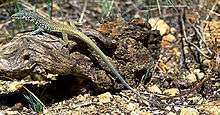Western whiptail
| Western Whiptail | |
|---|---|
| | |
| Scientific classification | |
| Kingdom: | Animalia |
| Phylum: | Chordata |
| Class: | Reptilia |
| Order: | Squamata |
| Suborder: | Sauria |
| Family: | Teiidae |
| Genus: | Aspidoscelis |
| Species: | A. tigris |
| Binomial name | |
| Aspidoscelis tigris (Baird and Girard, 1852) | |
| Synonyms | |
|
Cnemidophorus tigris Baird and Girard, 1852 | |
The western whiptail (Aspidoscelis tigris) is a small lizard that ranges throughout most of the southwestern United States and northern Mexico. Most of its populations appear stable, and is not listed as endangered in any of the states comprising its range. It lives in a wide variety of habitats, including deserts and semiarid shrubland, usually in areas with sparse vegetation; also woodland, open dry forest, and riparian growth. It lives in burrows. Major differences between this species and the checkered whiptail (Aspidoscelis tesselata) include the lack of enlarged scales anterior to the gular fold and the presence of enlarged antebatrachial scales. It was previously known under Cnemidophorus tigris, until phylogenetic analyses concluded that the genus Cnemidophorus was polyphyletic. Since it does not migrate, a number of forms have developed in different regions, several of which have been given sub-specific names - for example the California whiptail, Aspidoscelis tigris munda.
Description

The western whiptail has a long and slender body, small grainy scales on its back, and larger rectangular scales on its belly. Its upper side often has light stripes and its throat can be pinkish or somewhat orange when they are adults. Their maximum size is about 5 inches. Hatchlings are orange-yellow with dark brown-black spots or stripes.[2][3]
Range and habitat
The Western whiptail widespread throughout Northern Mexico and the Western United States. In the US it can be found in the states of California, Nevada, Oregon, Idaho, Utah, Arizona, Colorado and New Mexico.[4] They are found in hot dry regions, typically with sparse foliage. They can live in woodland, chaparral, riparian areas or desert. Desert subspecies prefer habitat with vegetation such as sagebrush or shadscale, and rely on burrows to escape the desert heat.[5][6][7]
In the Northern parts of its range, the western whiptail usually emerge from hibernation in May, and most adults aestivate during the midsummer months, but in the south the animals are active from April through late August. The seasonal period of activity is therefore considerably shorter in the North. Daily periods of activity are of similar duration from North to South, although the time of emergence tends to be later in Northern areas.
Reproduction and sexual characteristics
The western whiptail’s chromosomes show that they are polyploids. They are also a bisexual species. Usually in the northern end of their range, they mate in the first half of June while the females begin to lay eggs in late June. The eggs usually begin hatching by mid-August. Females will only lay one clutch (number of eggs laid at a single time) per year. At the southern end of their range, however, the females will begin to lay eggs as early as May and they will usually hatch as early as mid-June. In the southern end of their range, females may also lay two clutches per year instead of just one.[6][8][9]
Diet
The western whiptail mostly eats insects, spiders, scorpions, lepidopterans (butterflies and moths), crickets, grasshoppers, and beetles. They use their jaws instead of their tongue to capture their prey.[5][10]
Tail drop
When being attacked by a predator, the western whiptail will drop its tail. The muscles in the tail will continue contracting causing the tail to flop around. This is used to distract the predator from the lizard. However, this is a last ditch effort. It is very stressful for the lizard. It takes a lot of energy to regrow their tail, and they lose a lot of stored food. This is often a tactic they use with domestic and feral cats.[5]
External links
- www.natureserve.org — An excellent, well-documented site for information on this and other American species.
References
- ↑ Hammerson, G.A.; Frost, D.R. & Santos-Barrera, G. (2007). "Aspidoscelis tigris". IUCN Red List of Threatened Species. Version 2014.3. International Union for Conservation of Nature. Retrieved 16 December 2014.
- ↑ Hammerson, G. A. 1982. Amphibians and reptiles in Colorado. Colorado Division of Wildlife, Denver. vii + 131 pp.
- ↑ Cole, Charles J., Charles W. Painter, Herbert C. Dessauer, and Harry L. Taylor. "Hybridization Between the Endangered Unisexual Gray-Checkered Whiptail Lizard (Aspidoscelis dixoni) and the Bisexual Western Whiptail Lizard (Aspidoscelis tigris) in Southwestern New Mexico." American Museum Novitates 3555.1 (2007): 1-31. Web.
- ↑ "California Whiptail - Aspidoscelis tigris munda". www.californiaherps.com. Retrieved 2016-05-02.
- 1 2 3 Pianka, Eric R. (1970). "Comparative autecology of the lizard Cnemidophorus tigris in different parts of its geographic range". Ecology. 51 (4): 703–720. doi:10.2307/1934053. JSTOR 1934053.
- 1 2 Burkholder, Gary L. (1973). "Habitat and Reproduction of the desert whiptail lizard, Cnemidophorus tigris Baird and Girard in southwestern Idaho at the northern part of its range". Herpetologica. 29 (1): 76–83. JSTOR 3891208.
- ↑ McCoy, C. J. 1965. Life history and ecology of Cnemidophorus tigris septentrionalis. Ph.D. thesis, University of Colorado, Boulder.
- ↑ Vitt, Laurie J. "Ecology and Reproduction of Lower Colorado River Lizards: II. Cnemidophorus tigris (Teiidae), with Comparisons." Herpetologica 33.2 (1977): 223-34. JSTOR. Web. 10 Nov. 2014.
- ↑ Goldberg, Stephen R., and Charles H. Lowe. "The Reproductive Cycle of the Western Whiptail Lizard (Cnemidophorus tigris) in Southern Arizona." Journal of Morphology 118.4 (1966): 543-48. Web.
- ↑ Anderson, Roger A. "Energetics of the Lizard Cnemidophorus tigris and Life History Consequences of Food-Acquisition Mode." Ecological Monographs 58.2 (1988): 79-110. JSTOR. Web. 10 Nov. 2014.
